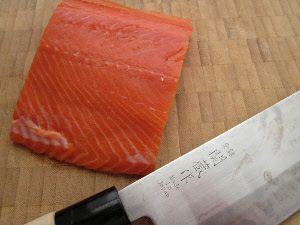
Since many organic compounds tend to accumulate in the fat tissue, this fish has
a higher propensity toward contamination with respect to the wild salmon. Studies
confirm that the population density in the fish farms leads to a high concentration
of pollutants which are found in the final meat product. Of particular concern is
the presence of cancer-
To make things more frightening, the Food and Drug Administration (FDA) is considering the approval of a genetically engineered salmon designed to grow to full size in half the time.
|
Optimal chooses
This list includes fishes that are farmed or harvested sustainably |
Acceptable options
These fishes can be added to your diet although their health or environmental impact are debated |
Fish to Avoid
These fish choices are known to present health or environmental hazards |
|
Arctic Char (farmed) Barramundi (US farmed) Catfish (US farmed) Clams (farmed) Cobia (US farmed) Cod: Pacific (Alaska longline) Crab: Dungeness, Stone Halibut: Pacific Lobster: Spiny (US) Mussels (farmed) Oysters (farmed) Sablefish/Black Cod (Alaska or BC) Salmon (Alaska wild) Scallops (farmed off- Shrimp, Pink (OR) Striped Bass (farmed or wild)* Tilapia (US farmed) Trout: Rainbow (farmed) Tuna: Albacore including canned white tuna (troll/pole, US and BC) Tuna: Skipjack including canned light tuna (troll/pole) |
Caviar, Sturgeon (US farmed) Clams (wild) Cod: Pacific (US trawled) Crab: Blue*, King (US), Snow Flounders, Soles (Pacific) Herring: Atlantic Lobster: American/Maine Mahi Mahi/Dolphinfish (US) Oysters (wild) Pollock (Alaska wild) Salmon (WA wild)* Sablefish/Black Cod (CA, OR and WA) Scallops: Sea Shrimp (US, Canada) Squid Swai, Basa (farmed) Swordfish (US)* Tilapia (Central America, farmed) Tuna: Bigeye, Yellowfin (troll/pole) Tuna: Canned white/Albacore (troll/pole except US and BC) |
Caviar, Sturgeon* (imported wild) Chilean Seabass/Toothfish* Cobia (imported farmed) Cod: Atlantic, imported Pacific Flounders, Halibut, Soles (Atlantic) Groupers* Lobster: Spiny (Brazil) Mahi Mahi/Dolphinfish (imported) Marlin: Blue*, Striped* Monkfish Orange Roughy* Salmon (CA, OR* wild) Salmon (farmed, including Atlantic)* Sharks*, Skates Shrimp (imported) Snapper: Red Swordfish (imported)* Tilapia (Asia farmed) Tuna: Albacore, Bigeye, Yellowfin (longline)* Tuna: Bluefin*and Tongol Tuna: Canned (except troll/pole)* |
|
* Consumption of these items should be limited due to concerns of contamination from mercury or other chemicals
| ||
In the interest of aiding the consumer, several organizations compiled lists that categorize fish species according to their health and environmental impact. This year, the Monterey Bay Aquarium distributed 6 useful, regional pocket guides to help the consumer choose fish consciously. The National Sustainable Seafood Guide, reproduced below, groups fishes common in North America according to their health/environment "friendliness". Other lists for specific geographic regions of the US are available for download.
So what about those of us who can't resist sushi and want to make the right choice at the restaurant? The scientists at the Monterey Bay Aquarium have thought about that too. The Sushi Seafood Watch pocket lists common sushi fish to help you make an educated pick when you scroll through the restaurant menu. And for those who can't stop typing on their smart phone when they are eating, these lists are available as a useful iPhone app.

Taking these studies into account, the experts' recommendations on salmon consumption
vary. While some nutritionists think that the benefit of eating omega-
Government agencies (the Environmental Protection Agency (EPA), the FDA, and the American Hearth Association (AHA)) also have conflicting recommendations which probably arise from their different legislative mandates.
Your diet customized with one click!
One
Click
Diet
One
Click
Diet

Copyright © 2010 OneClickDiet.com All right reserved.
No part of this web-
Disclaimer: The information provided on this site is for informational purposes only and is not a substitute for medical or nutritional advice, or treatment for any medical conditions. You should consult a healthcare professional or nutritionist before starting any diet, exercise or supplementation program, or if you have or suspect you might have a health problem. Actual results from nutritional plans and diets as well as exercise activities usually vary among individuals. The products and the claims made about specific products on or through this site have not been evaluated by the United States Food and Drug Administration (US F.D.A.) and are not intended to diagnose, treat, cure or prevent any disease. You should not use the information on this site for diagnosis or treatment of any health problem or for prescription of any medication or other treatment. Please view our full "Terms Of Use" for more information and the terms and conditions governing your use of this site.
Home
About
Contact us
